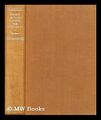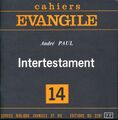Category:Intertestamental Judaism (subject)
Intertestamental Judaism is one of the traditional terms for Second Temple Judaism.
Overview
The concept of "intertestamental" Judaism has been one of most successful Christian models of interpretation of Second Temple Judaism. From the Christian point of view the period between the Babylonian Exile and the Jewish War appeared to be the connecting age between the Old Testament and the New Testament.
It was the British scholar Humprey Prideaux who in 1716-18 published the first introduction to "intertestamental" Judaism, which could serve both as a epilogue to the Old Testament and a prologue to the New. Christian scholars and theologians enthusiastically accepted the category, which allowed them to give sense to a previously insignificant period. There were discussion weather this period was a mere intermission (a period of silence between the ancient prophecies and their fulfillment in Christ), or a time of religious decadence, or on the contrary a period of creativity that "helped" the emergence of Christianity, but the teleological approach provided a comfortable framework in which Christian theology did not feel challenged by scholarly research. At the end it was the rise of anti-semitism that at the turn of the 20th century largely overshadowed the term and concept. "Intertestamental" appeared too a neutral and soft term to denote an "uncivilized" and obsolete religion (Late Judaism), which at the conclusion of its providential task of being the (hostile) cradle of Christianity deserved only to die with contempt.
The concept of "Intertestamental Judaism" knew a remarkable recovery and revival after War World II, when it appeared as a less derogatory and more neutral category for scholarly research (Russell, Gowan, Paul). It gave scholars and Christian theologians the time out they needed to cope with the guilt of the Holocaust and absorb the profound impact of the discoveries of Nag Hammadi and Qumran. In the 1980s and 1990s, the theological implications of the term came to be openly criticized by a growing number of scholars (James H. Charlesworth, Gabriele Boccaccini), who pointed at the many ideological and chronological inconsistencies of the concept of "Intertestament". New terms emerged, such as Early Judaism or Middle Judaism, which emphasized that the period was not the end of Judaism before the emergence of Christianity but a time of great creativeness as well as the beginning of new developments in the Rabbinic tradition. In addition, Jesus and his movement could not be taken away from their environment and located at the conclusion of a period of which they were major actors and components.
Today, after almost three centuries of glorious service, the concept of intertestamental Judaism has been virtually abandoned by contemporary scholarship. More and more rarely used, it survives only in the theological language of some conservative Christian circles.
External links
Pages in category "Intertestamental Judaism (subject)"
The following 40 pages are in this category, out of 40 total.
1
- Histoire des juifs et des peuples voisins = The Old and New Testament Connected in the History of the Jews, and Neighbouring Nations (1722 @1716-1718 Prideaux / Brutel), book (French ed.)
- A Compendium of the History of the Jews from the Time of Nehemiah and Malachi to the Birth of Christ (1827 Clarke), essay
- Specimen historico-theologicum; quo continetur, Historia conditionis judaeorum religiosae et moralis inde ab exsilo Babylonica usque ad tempora J.C. immutatae (1834 Boon), book
- Connexion of Sacred and Profane History... from the Close of the Old Testament History, till the Establishment of Christianity (1845 Davidson), book
- A Manual of the Whole Scripture History, and of the History of the Jews between the Periods of the Old and New Testaments (1857 Riddle), book
- Brief Summary of Material and Chronological Facts, to Connect the Old with the New Testament (1862 Perceval), non-fiction
- Four Centuries of Silence; or, From Malachi to Christ (1885 Redford), book
- From Malachi to Matthew (1893 Moss), book
- From the Exile to the Advent (1895 Fairweather), book
- Between the Testaments (1907 Grant), book
- Between the Testaments; or, Interbiblical History (1907 Gregg), book
- Die jüdische Religion von der Zeit Esras bis zum Zeitalter Christi (1911 Bertholet), book
- 舊新約間之宗敎 (1926 Charles / Throop, Huang) = Religious Development between the Old and the New Testaments (1914 Charles), book (Chinese ed.)
- The Bridge Between the Testaments (1929 Booth), book
- From Babylon to Bethlehem: A Survey of Interbiblical History (1929 McGinty), book
- Zwischen den Testamenten = Between the Testaments (1962 Russell), book (German ed.)
- (++) From the Exile to Christ: A Historical Introduction to Palestinian Judaism = Das Judentum Palästinas zur Zeit Jesu und der Apostel (1964 @1959 Foerster / Harris), book (American ed.)
- Palestinian Judaism in New Testament Times = Das Judentum Palästinas zur Zeit Jesu und der Apostel (1964 @1959 Foerster / Harris), book (British ed.)
- Bibliographie zur jüdisch-hellenistischen und intertestamentarischen Literatur, 1900-1965 (1969 Delling), book
- El período intertestamentario = Between the Testaments (1973 @1960 Russell / Marín), book (Argentine ed.)
- From Babylon to Bethlehem: The Jewish People from the Exile to the Messiah (1976 Ellison), book
- The Development of Jewish Religious Thought in the Inter-Testamental Period (1976 Whitelocke), book
- 신구약중간사 : 포로시대부터그리스도까지 = From the Exile to Christ (1977 Foerster / Mun), book (Korean ed.)
- Che cos'è l'intertestamento (1978 Paul / Comunità di Bose), book (Italian ed.)
- Intertestamento (1978 Paul), book (Spanish ed.)
- 兩約中間史略 (Intertestamental History / 1978 Xie), book
- Sin-Kuyak chunggansa (1984 Surburg / Kim), book (Korean ed.)
- 從巴比倫到伯利恆 = From Babylon to Bethlehem (1987 Ellison / Chen), book (Chinese ed.)
- 兩約之間 = Between the Testaments (1989 Russell / Xuan), book (Chinese ed.)
- Il giudaismo intertestamentario (1991 Cavalletti), book
- Il giudaismo del secondo tempio (1991 Maier / Chiesa) = Zwischen den Testamenten (Between the Testaments / 1990 Maier), book (Italian ed.)
- Intertestamental history (1993 Lee), book
- Sin-Kuyak chunggan sidae (1995 Russell / Im), book (Korean ed.)
- Customs and Controversies: Intertestamental Jewish Backgrounds of the New Testament (1995 Scott), book
- Entre los dos Testamentos: Historia y religión en la época del Segundo Templo (1996 Maier), book (Spanish ed.)
- Letteratura giudaica intertestamentaria (1998 Aranda Pérez/Pérez Fernández/García Martínez), book (Italian ed.)
2
- Miedzy Starym a Nowym Testamentem (2002 Maier), book (Polish ed.)
- The Antichrist Theme in the Intertestamental Period (2003 Lorein), book
- 圖片兩約之間四百年 (400 Years of Intertestamental History in Pictures / 2005 Ta), book
- 中間時代のユダヤ世界 : 新約聖書の背景を探る = Customs and Controversies: Intertestamental Jewish Backgrounds of the New Testament (2007 Scott / Inoue), book (Japanese ed.)
Media in category "Intertestamental Judaism (subject)"
The following 16 files are in this category, out of 16 total.
- 1716 * Prideaux.jpg 435 × 750; 113 KB
- 1914 * Charles.jpg 333 × 500; 34 KB
- 1937 * Walker.jpg 300 × 357; 12 KB
- 1960 * Russell.jpg 339 × 499; 39 KB
- 1960 * Toombs.jpg 658 × 1,000; 100 KB
- 1964 * Sloan.jpg 667 × 1,000; 35 KB
- 1965 * Howie.jpg 750 × 1,000; 77 KB
- 1975 * Paul.jpg 776 × 790; 69 KB
- 1975 * Surburg.jpg 680 × 1,000; 33 KB
- 1976 * Gowan.jpg 333 × 500; 39 KB
- 1977 * Moeller.jpg 343 × 499; 47 KB
- 1980 * Gowan (II).jpg 300 × 445; 37 KB
- 1985 * Gowan (III).jpg 333 × 499; 22 KB
- 1983 * McNamara.jpg 635 × 1,000; 89 KB
- 1990 * Maier.jpg 330 × 499; 21 KB
- 1996 * Aranda Garcia Perez.jpg 340 × 500; 26 KB















